The Kaveri Refresh 'Godavari' Review: Testing AMD's A10-7870K
by Ian Cutress on June 1, 2015 11:59 AM ESTOffice Performance
The dynamics of CPU Turbo modes, both Intel and AMD, can cause concern during environments with a variable threaded workload. There is also an added issue of the motherboard remaining consistent, depending on how the motherboard manufacturer wants to add in their own boosting technologies over the ones that Intel would prefer they used. In order to remain consistent, we implement an OS-level unique high performance mode on all the CPUs we test which should override any motherboard manufacturer performance mode.
All of our benchmark results can also be found in our benchmark engine, Bench.
Dolphin Benchmark: link
Many emulators are often bound by single thread CPU performance, and general reports tended to suggest that Haswell provided a significant boost to emulator performance. This benchmark runs a Wii program that raytraces a complex 3D scene inside the Dolphin Wii emulator. Performance on this benchmark is a good proxy of the speed of Dolphin CPU emulation, which is an intensive single core task using most aspects of a CPU. Results are given in minutes, where the Wii itself scores 17.53 minutes.
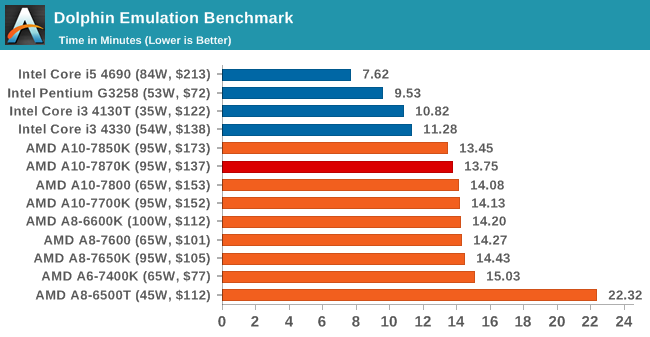
WinRAR 5.0.1: link
Our WinRAR test from 2013 is updated to the latest version of WinRAR at the start of 2014. We compress a set of 2867 files across 320 folders totaling 1.52 GB in size – 95% of these files are small typical website files, and the rest (90% of the size) are small 30 second 720p videos.
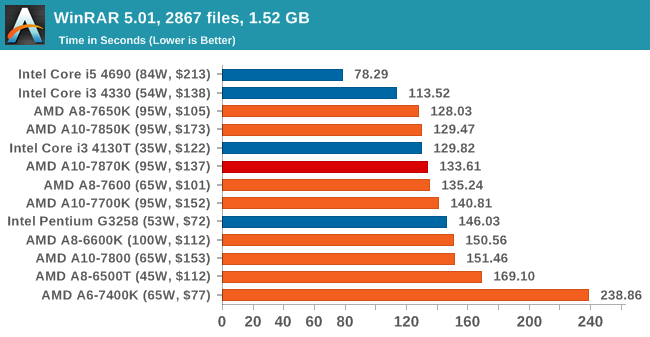
3D Particle Movement
3DPM is a self-penned benchmark, taking basic 3D movement algorithms used in Brownian Motion simulations and testing them for speed. High floating point performance, MHz and IPC wins in the single thread version, whereas the multithread version has to handle the threads and loves more cores.
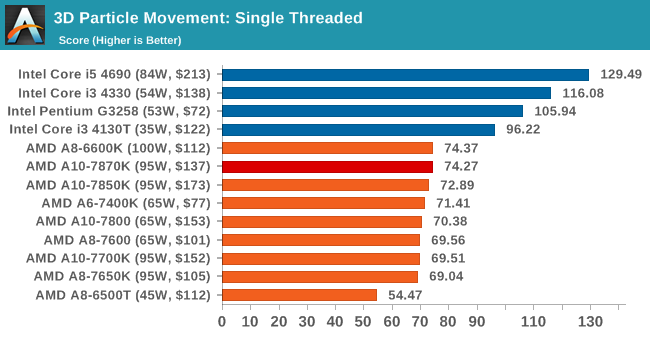
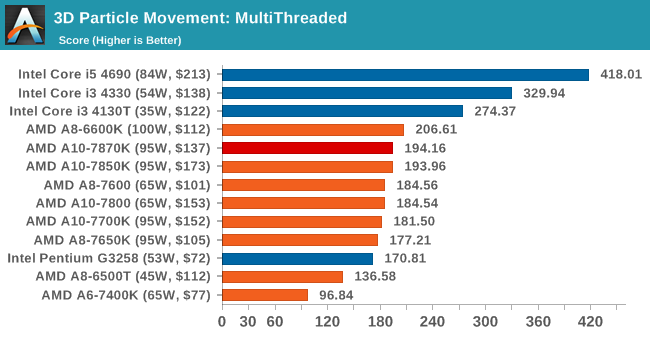
FastStone Image Viewer 4.9
FastStone is the program I use to perform quick or bulk actions on images, such as resizing, adjusting for color and cropping. In our test we take a series of 170 images in various sizes and formats and convert them all into 640x480 .gif files, maintaining the aspect ratio. FastStone does not use multithreading for this test, and results are given in seconds.
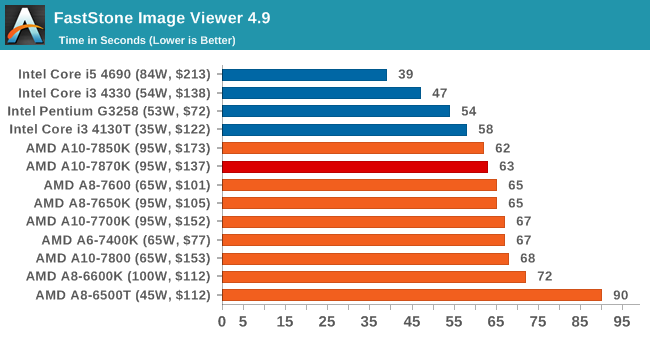
Web Benchmarks
On the lower end processors, general usability is a big factor of experience, especially as we move into the HTML5 era of web browsing. For our web benchmarks, we take four well known tests with Chrome 35 as a consistent browser.
Sunspider 1.0.2

Mozilla Kraken 1.1
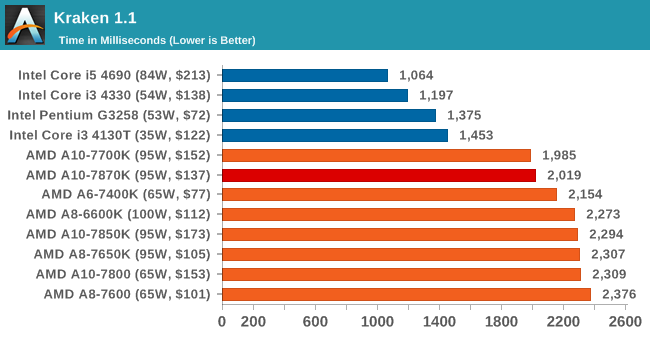
WebXPRT
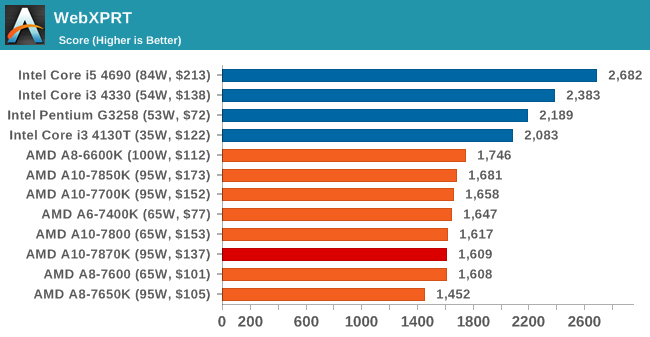
Google Octane v2
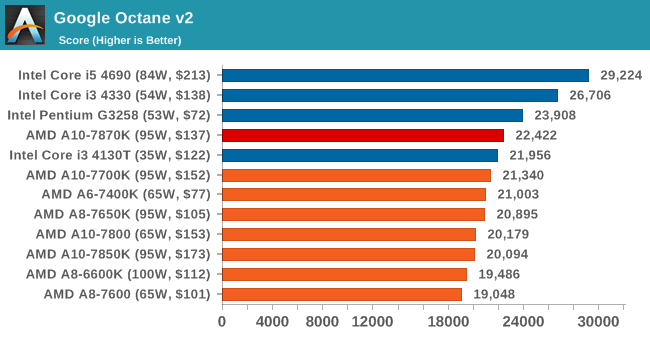










140 Comments
View All Comments
anubis44 - Wednesday, June 3, 2015 - link
Dual-core CPUs are dead men walking for gaming. If you've already got one, fine, you'll have to upgrade very soon. But recommending buying a dual-core chip NOW is uttery unconsionable, unless it's for your grandmother to play solitaire. The damn thing will choke just running windows and a web browser these days.anubis44 - Wednesday, June 3, 2015 - link
@RafaelHershel: "Less power means less heat and less noise. It also means better performance in a (very) small case. It also means a more modest PSU."But it's a question of proportion. How much money do you think you're saving in electricity by paying a lot more for an Intel processor? Check this out:
https://www.youtube.com/watch?v=fBeeGHozSY0
Not to mention in buying Intel and nVidia, you're supporting two companies with proven track records of ripping off customers, but please go right ahead and blithely do it.
jonez - Friday, June 5, 2015 - link
Why use a 4 years old linux distribution, it's even older than most of the hardware being benchmarked?And running it live it's not ideal too, but for the purpose of intra-comparison it's not that relevant, I guess.
ES_Revenge - Saturday, June 6, 2015 - link
I still don't understand why the Dual Graphics tests are not including Frame-Time Variance numbers/charts. It's one thing to have nice FPS from Dual Graphics but if the FTV is bad enough that it makes it no better than being on the solo-card (or the APU solo) then those numbers quickly become meaningless. Anandtech has commented on dual-GPU FTV stuff before, so I'm puzzled as to why it's not even mentioned as even a possible concern here with the Dual Graphics tests of the last few AMD APUs.ssv - Wednesday, June 10, 2015 - link
totally, off the track. Why is that AMD architectures are named after Indian rivers? Kaveri and Godavari are rivers in south India. I am not sure if earlier "Bima" refers to Bhima (indian again) mythological character.P39Airacobra - Sunday, June 21, 2015 - link
Sorry but 30fps at low settings and 720p is not what I would consider gaming capable! These APU's are just a waste of money! You can buy a X4 860K CPU and a old R7 260 for about the same price and actually be able to game!ricster7227@gmail.com - Tuesday, July 21, 2015 - link
I am presently running the A 5800 k APU for a couple + years and have waited a few cycles here and will take the plunge for this new chip. I presently OC to 5600 with an H-105 pushpull at about 36 degrees under load and it will be interesting to see the difference in performance and operation. I suspect this will improve my experience until my next build I7 or Zeons with ECC.ricster7227@gmail.com - Sunday, August 23, 2015 - link
The new APU is much stronger and faster than my A 5800 k. It is clocked at4400 which is slower however it is much faster for the normal office and light gaming. I can now do intensive rendering, watch and record HD video and surf the web at the same time. It stays under 30 degrees, doesn't slow down and hasn't crashed at all. I'm running the latest Insider 2010. It is a welcome addition and has increased my productivity by about double overall.gearhead99 - Monday, September 28, 2015 - link
the APU stuff is great for laptops, gimme gimme, but i don't see a good case for AM1 or FM2+. flexible upgrade path - no / cheap ECC - no / good IPC - no / good TDP - no / many cpu cores - no / low price - no. its especially unfortunate AMD has abandoned ECC. regardless of all the groaning over IPC, the bang4buck was pretty solid on AM2>AM3+SviatA - Friday, October 16, 2015 - link
Honestly, I wouldn't buy any video card in addition to any AMD APU. For me, gaming performance of my build is irrelevant since I don't like playing games. So if you are not going to do that (or use Adobe Photoshop for photo editing) then forget about Intel. APUs are good enough on power consumption and performance for simple home tasks.The only issue is that AMD doesn't really develop its processors. Which is a shame since they could give us impressive stuff. http://hardware.nl/amd/ad7600ybjabox.html - less than a 100, but performance wise, it will work fine.